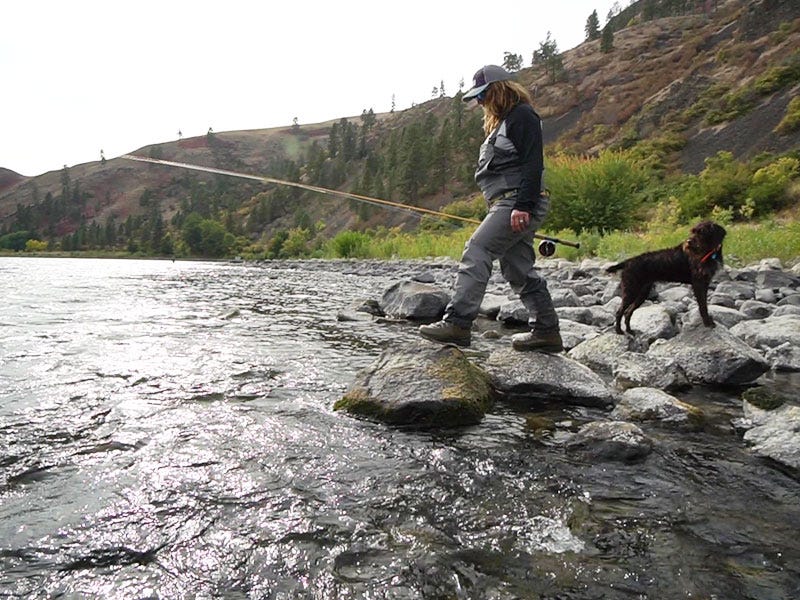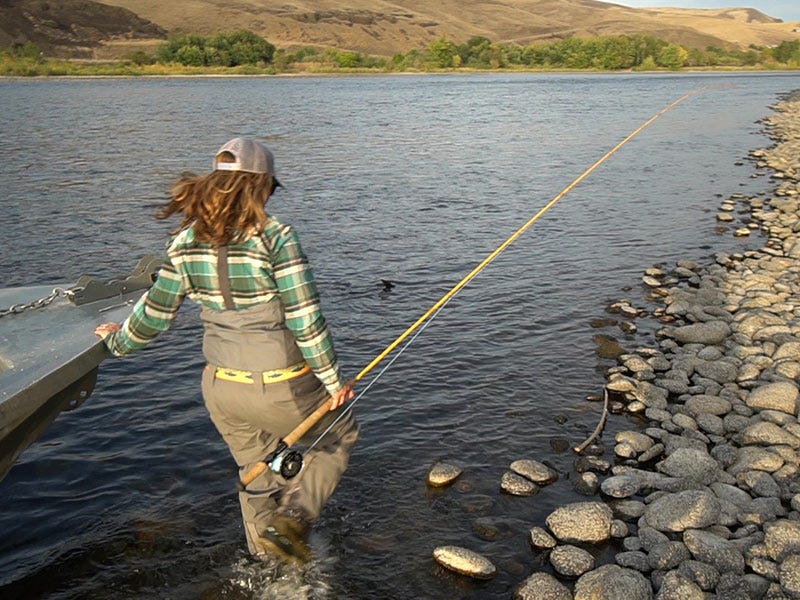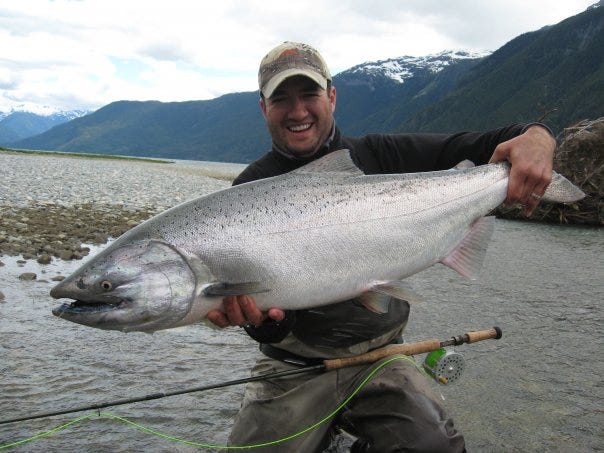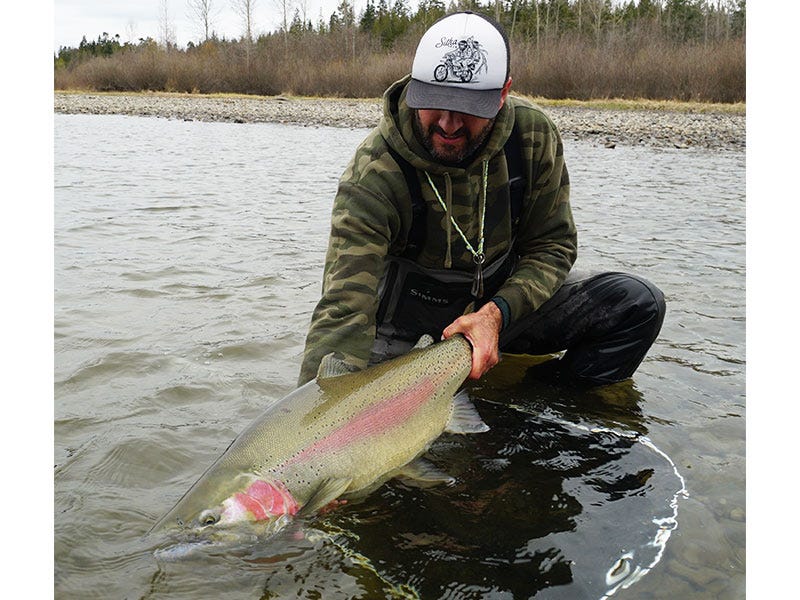Pros & Cons of Skagit, Scandi, and Long Belly Spey Lines

I first heard of Spey casting in 2013 and was instantly confused and excited at the same time. What confused me was the idea of casting with two hands? I was standing in a riffle on the Boise River when my buddy Kamas told me about it. Puzzled, I knew I had to get my hands on a stick and try it out for myself. What excited me was the idea of dropping fifty to a hundred feet of line with ease. Knowing I couldn’t cast 65 feet of line with my single hander at that time. So, I saved my pennies and ended up buying a Redington Dually 8136-4 kit that came with a Redington Surge reel, Gripshooter running line, and a 600 grain Rio Skagit Max shooting head. With a head full of confidence, I headed to the river to give it a try.
Which Spey rod is the best for you? You'll want to check these out.

My first time out “casting” was a joke. I was horrible. I ended up snapping the loop on the front of the taper, sending my sink tip across the river to be lost forever. I contacted Rio and had a replacement line sent to me -unbeknownst to me, that I would do the exact same thing with the new line too. I was standing in that same riffle when I snapped that line, pissed at the world. I yelled to my buddy Kamas, “…I am never doing this bleepity bleep Spey casting again!!” I was ready to give up and sell my rod. He coerced me to not give up and explained that I would get the cast with time. The next day I went to my local fly shop, Idaho Angler, and had them weld the tip closed. I then went right back to the river. It was still very difficult, but I had slowed down, sat with patience, and slowly started to get the cast.
Little did I know, at the time, that this journey would lead me to be the manager of a fly shop in the first port of entry for the mighty Idaho steelhead. Steelhead are the reason why I got into Spey casting. I was so enamored by them when I fished with conventional rods, I couldn’t believe that you could catch them with a fly rod. Spey casting has brought me from a trouble-making past to an individual who sits with a lot more peace than in my prior years. It has taught me to slow down and not to worry about fish numbers, giving myself the idea of enjoying the experience and the moment. Being here, now.
I wanted to write an article to gives an idea of the different amount of lines that are offered to us anglers. It can be confusing for the first time Spey caster or any of you looking to get into it. Now, I am no expert like the legends and line developers who cut their teeth Spey casting on the Grande Ronde and Clearwater Rivers, yet, I do have some sort of idea that has brought fish to my hand. I am going to give you the knowledge I have learned over my career and passion for this so-called two-hand stick waving.
Is Spey the way? Read more here.
What are Skagit Lines
Skagit lines were developed by a group of anglers who found effectiveness in casting big, heavy steelhead flies. Some of those anglers include Scott O’Donnell, Ed Ward, and Dec Hogan. The innovators found that swinging large profiled flies with a sink tip in deeper holding water for winter steelhead was more productive than the older methods of using floating lines.
Skagit Lines Pros
When casting a heavier line like a Skagit, I have found that it will give you a great representation of the action of the rod. With the line being heavier and thicker than other Spey lines, Skagit lines load the rod deep into the cork. This gives you a feeling of how much the rod can handle as well as the amount of force you can give it. You’ll find that casting heavier flies is a breeze with a Skagit line. The line has enough mass to get the right inertia that is needed to pick those heavy, half-of-a-dead chicken flies, out of the water.
Regarding sink tips, they are a very effective tool that help you fish your fly at a depth that a pesky fish is sitting at. Sink tips can be mended and managed in a manner that can get the fly down faster at the beginning of the swing. Also, Skagit lines are shorter than other Spey lines, so they can fish the holding areas that are tighter to the bank. This ensures that you aren’t overfishing those buckets. You can also cast them in an area that doesn’t have a lot of backcasting room. You can learn the cast a lot easier with a Skagit because of its short casting stroke. The casting stroke is easier to time and makes for less of a hiccup.
Looking for effective sink tips? Order online here.
Skagit Lines Cons
Skagit lines are clunky. It takes a lot more energy to lift and cast the line. This brings the fly down at a rate that has a lot of eruptive impact when it hits the water -potentially spooking a wary fish. If you are fishing a run that has multiple different micro-currents as well as undertows, your swing can come through the zone choppy. Therefore, it makes it harder to tell when a fish has struck your fly. When swinging a sink tip, it puts you at the depth of where the fish might be holding as I mentioned earlier, but it can also have you fishing beneath the fish. This makes it ineffective to catch a fish that isn’t going to move to the fly. Also, if you aren’t a proficient caster you can tire very quickly casting a Skagit line all day long. With shooting heads requiring shooting line, this means you have to strip the line back in after each cast, causing you to not have as much fishing time.

What are Scandi Lines
With the name “Scandi,” I would entertain the fact that you might be able to guess where these fly lines came from? Scandinavia! Scandinavia is known for its Atlantic salmon and brown trout fishing in the streams that inhabit the country. Over in those parts, the casting room is not ideal for traditional lines. So, the anglers adopted the cast from traditional lines to cast shorter shooting head lines. This allowed them to be able to cast in tight-knit quarters.
Scandi Lines Pros
A pro of Scandi lines is that the presentation can be very delicate, giving your fly a wonderful kiss when laid out with a smooth cast. Scandi is also a great shooting head to learn on. You can learn every Spey cast that has been developed. For example, you can learn the concept of touch and go casting, which is a style of casting where you let the line kiss the water and anchor for the least amount of time before you shoot it out. This can help you work your way up to the more traditional long belly fly lines. You can cast a floating, intermediate, or slow sinking polyleader that can get your fly into a different zone the fish are in. When you have those windy days, quite common around Lewiston, a Scandi can be a good choice to punch some casts out there. You’ll find that shorting your cast will be more effective than trying to punch a long cast through the air.
Scandi Lines Cons
I have found that there are not too many negatives to Scandi lines. One problem is that you cannot cast big heavy flies. Why this can be a problem is the fact that you would have to change out your shooting head in order to cast those flies. If you think the fish is holding in a lower part of the water column, this takes away from your fishing time. The sweep to place your anchor (the step of the cast that loads the rod) can be hard to time. When your timing is off you tend to have pile ups and a cast that won’t shoot.

What are Traditional/Long Belly Lines
Scotland is the place of origin for Spey casting. Spey casting got its name from the river Spey. Folks who first started using this method to fish would go to the river and fish these so-called “beats.” Ghillies was the Scot’s name for a guide in that time. These Ghillies would be a manager of the beat, making the beat their home away from home. These methods of casting have helped sculpt the modern day fishing we anglers use to catch multiple species of fish.
Long Belly Lines Pros
I am roughly new to casting “looong belly” lines, these are the pros that I have learned by observing and participating in this tackle method. To begin, my conclusion is that the efficiency you gain when stepping up to a traditional line changes the game. It allows you to cast 54 to 70 feet at the drop of a dime. This will give you the most amount of time to fish. If you like to fish in the winter time, which can produce a lot of fish in the Lewiston area, I have found that the days become more efficient when there is not ice in the guides. When you are casting a longer line, you don’t have to strip much line in. This leaves less ice in the guides. The long bellies swing through runs very smoothly, crisply, and are easy to control during your swing to make a beautiful swing. (Line control can be very important during this game.)
Long Belly Lines Cons
Windy days suck! A con of long belly lines is that it can be very difficult to cast a long line when the fan is on. Due to the taper, these lines have a tough time cutting through the wind. Shortening your cast will help in this situation. It can be very difficult to learn the different casts, and timing is crucial and comes with repetitious effort. However, do not give up! With perseverance, you will perfect the cast.
Another con of long belly line is that line twist can be an issue. When you do continuous cast, the line tends to twist a half turn, or so, with each cast. Over time, you will notice that the line is not casting well and looks a little choppy in a swing. The solution to fix this is to cut off the fly, cast the line multiple times, and let the current untwist the line. Also, it is also very easy to get a tailing loop if your cast is not anchored right -leading to a blow anchor. Eddies can also affect your ability to pick up the fly line at the beginning of the cast. This wastes fishing time.
There you have it, folks. The take away is that each line has its time to be fished. They all work the same, to catch fish! If you continue on your journey with a two-handed rod, you will find a life full of peace and a whole lot of joy. These rods, lines, and casts have sculpted me into the human I am today. I owe my life to fly fishing. So, please do yourself a favor and learn the ancient method of Spey casting.

